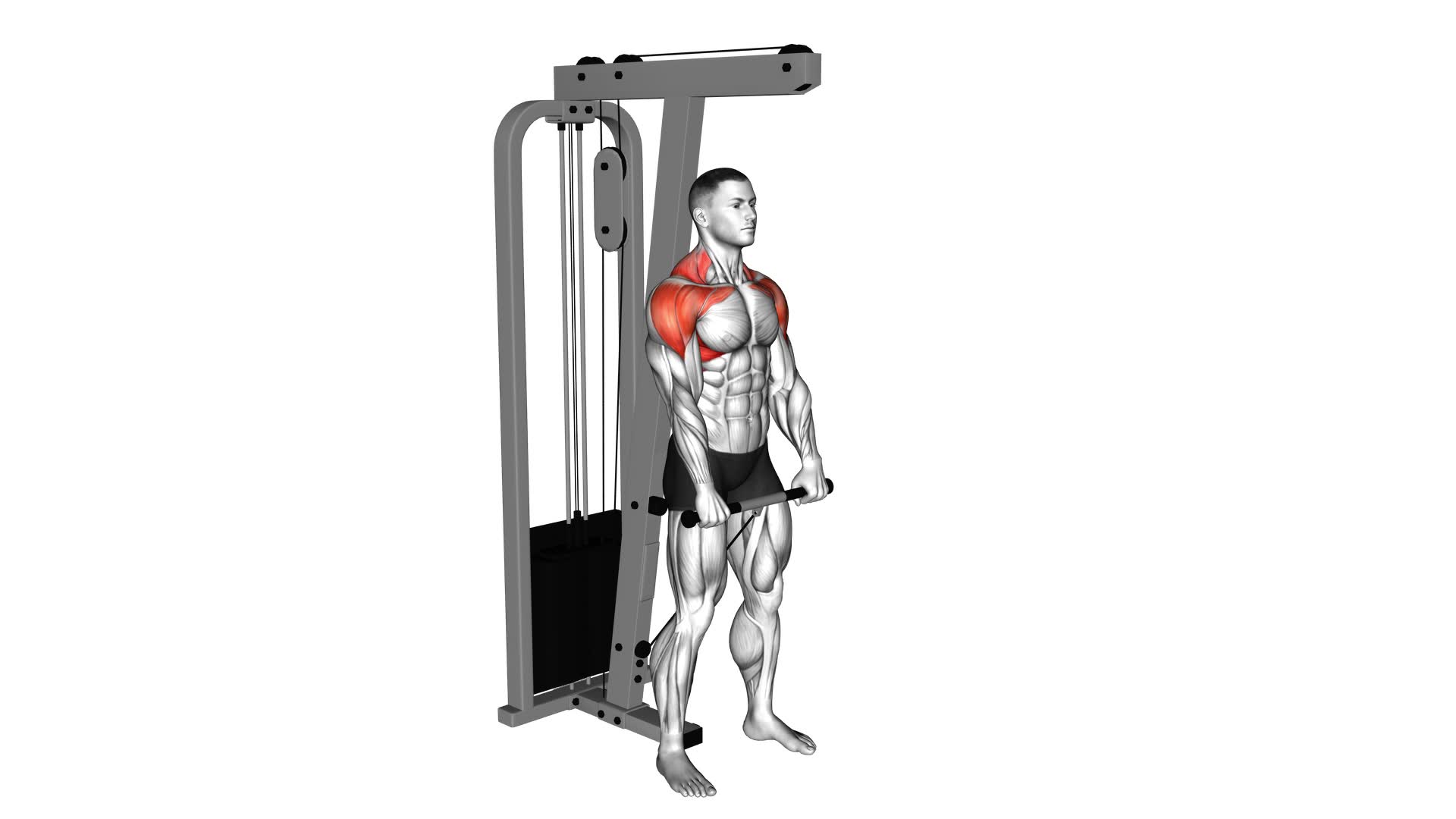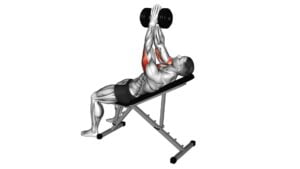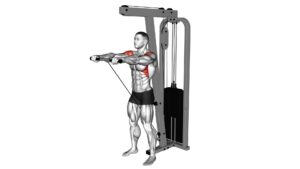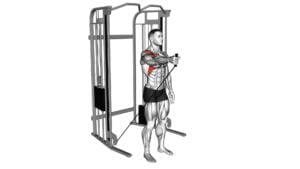Cable Standing Front Raise Variation – Video Exercise Guide & Tips

Are you looking to add some variety to your workout routine?
Watch This Exercise Video
Check out the Cable Standing Front Raise Variation!
This exercise targets your shoulder muscles and helps improve upper body strength.
In this video exercise guide, you'll learn the proper form and technique, as well as common mistakes to avoid.
With variations and modifications to suit your fitness level, you'll be able to maximize the benefits of this exercise.
Get ready to elevate your workout with the Cable Standing Front Raise Variation!
Key Takeaways
- Increased resistance for effective muscle challenge
- Constant tension throughout the entire movement
- Greater range of motion for targeting different muscle fibers
- Improved strength and muscle growth in shoulders and upper body
Benefits of the Cable Standing Front Raise Variation
What are the benefits of the Cable Standing Front Raise Variation for you?
The Cable Standing Front Raise Variation is a modification of the traditional standing front raise exercise that involves the use of a cable machine. This modification offers several benefits that can enhance your workout routine.
One of the main benefits of the cable standing front raise modification is the increased resistance it provides. By utilizing the cable machine, you can adjust the weight to challenge your muscles more effectively. This can lead to improved strength and muscle growth in your shoulders and upper body.
Another advantage of this variation is the constant tension it creates throughout the entire movement. Unlike dumbbells or barbells, the cable machine provides a steady resistance throughout the exercise, ensuring that your muscles are engaged throughout the entire range of motion.
Additionally, the cable standing front raise variation allows for a greater range of motion compared to traditional front raises. This increased range of motion can help to target different muscle fibers and promote better muscle development.
Proper Form and Technique for the Cable Standing Front Raise Variation
To perform the Cable Standing Front Raise Variation with proper form and technique, you should follow these guidelines:
- Stand with your feet shoulder-width apart and grasp the cable handle with an overhand grip.
- Keep your core engaged and maintain a slight bend in your knees throughout the exercise.
- Slowly raise the cable handle in front of you, keeping your arms straight and your shoulders relaxed. Stop when your arms are parallel to the floor.
- Hold the position for a brief moment, focusing on squeezing your shoulder muscles.
- Slowly lower the cable handle back to the starting position, maintaining control and resistance.
- Repeat for the desired number of repetitions.
Common mistakes to avoid:
- Using momentum to raise the cable handle, rather than relying on your shoulder muscles.
- Raising the cable handle too high, which can place unnecessary stress on your shoulder joints.
- Allowing your back to arch or your shoulders to shrug during the movement.
Variations and modifications:
- If you have shoulder issues, you can perform the exercise with lighter weights or resistance bands.
- To increase difficulty, you can perform the exercise with a single arm or alternate arms.
Common Mistakes to Avoid During the Cable Standing Front Raise Variation
To avoid common mistakes during the Cable Standing Front Raise Variation, you should focus on proper form and technique. One of the most important aspects is proper positioning. Many people make the mistake of using too much momentum or swinging their body to lift the cable. This not only reduces the effectiveness of the exercise but also puts unnecessary strain on the muscles and joints. To avoid this, make sure to stand with your feet shoulder-width apart and maintain a stable stance throughout the movement.
Another common misconception is that lifting heavier weights will yield better results. While it's important to challenge yourself, using weights that are too heavy can lead to poor form and increased risk of injury. Start with lighter weights and focus on performing the exercise correctly before gradually increasing the resistance.
Furthermore, it's crucial to keep the movement controlled and avoid any jerking or sudden movements. This ensures that you're targeting the correct muscles and maximizing the benefits of the exercise. Remember to engage your core and keep your back straight throughout the movement.
Variations and Modifications for the Cable Standing Front Raise
To further enhance your Cable Standing Front Raise, there are several variations and modifications you can incorporate. These cable variations and modification tips will help you target different muscles and add variety to your workout routine:
- Single Arm Cable Standing Front Raise: Instead of using both arms simultaneously, perform the exercise with one arm at a time. This variation allows for a greater focus on each side of the body and helps to correct any muscle imbalances.
- Low Cable Standing Front Raise: Lower the cable pulley to a position below your waist. By performing the exercise in this position, you'll engage the lower portion of your deltoids and challenge your shoulder stability in a different way.
- Cable Standing Front Raise with Rotation: Start the exercise with your palms facing down and as you raise your arms, rotate your wrists so that your palms face up at the top of the movement. This modification helps to engage your forearm muscles in addition to your shoulders.
Tips for Getting the Most Out of Your Cable Standing Front Raise Workout
Maximize your Cable Standing Front Raise workout by following these tips to ensure you're maximizing results and preventing injuries.
Firstly, it's crucial to maintain proper form throughout the exercise. Start with a light weight and focus on the movement, keeping your core engaged and your back straight. Avoid using momentum or swinging the weight, as this can put unnecessary strain on your muscles and increase the risk of injury.
Secondly, control the speed of the movement. Slow and controlled repetitions will engage your muscles more effectively and prevent any jerking or bouncing that could lead to injury. Aim for a steady and controlled pace, taking the time to really feel the tension in your muscles.
Additionally, it's important to choose an appropriate weight for your fitness level. Select a weight that challenges you, but still allows you to maintain proper form and complete a full range of motion. Gradually increase the weight as you get stronger, but always prioritize form and safety over lifting heavier weights.
Finally, listen to your body and take breaks when needed. If you start to feel any pain or discomfort, stop the exercise and assess your form. It's better to take a short break and correct your technique than to push through and risk injury.
Frequently Asked Questions
How Many Sets and Reps Should I Do for the Cable Standing Front Raise Variation?
To determine the number of sets and reps for the cable standing front raise variation, it's important to consider your fitness goals and current ability.
The optimal rep range for this exercise is typically 8-12 reps per set.
Start with 2-3 sets and gradually increase the number as you get stronger.
Remember to listen to your body and adjust accordingly.
Consult a trainer for personalized guidance.
Can I Use Dumbbells or Resistance Bands Instead of a Cable Machine for This Exercise?
Yes, you can use dumbbells or resistance bands instead of a cable machine for the cable standing front raise variation. However, using a cable machine offers certain benefits over using dumbbells or resistance bands.
Cables provide constant tension throughout the exercise, targeting your muscles more effectively. They also allow for a wider range of motion, helping you engage different muscle fibers.
Is It Necessary to Warm up Before Performing the Cable Standing Front Raise Variation?
Yes, it's necessary to warm up before performing the cable standing front raise variation. Dynamic warm up exercises help increase blood flow to your muscles, improve joint mobility, and reduce the risk of injury.
Before starting the exercise, make sure to engage your core, keep your back straight, and lift the cable in a controlled manner.
Can I Incorporate This Exercise Into a Full-Body Workout Routine?
Incorporating the cable standing front raise into your full-body workout routine can be a great way to target and develop your shoulder muscles. This exercise provides benefits such as increased shoulder strength and stability.
By adding the cable standing front raise to your workout, you can engage your shoulder muscles in a different way and enhance overall upper body strength.
Consider including this exercise in your routine for a well-rounded and effective workout.
What Muscles Does the Cable Standing Front Raise Variation Target?
The cable standing front raise variation targets several muscles in your upper body.
It primarily works your anterior deltoids, which are the muscles at the front of your shoulders.
Additionally, it engages your lateral deltoids and upper chest muscles.
This exercise also recruits your trapezius muscles, which are located in your upper back.
Conclusion
In conclusion, the cable standing front raise variation is a beneficial exercise for targeting the front deltoids and improving shoulder strength. By maintaining proper form and avoiding common mistakes, you can maximize the effectiveness of this exercise.
Additionally, there are variations and modifications available to cater to different fitness levels and goals. Remember to follow the tips provided to get the most out of your cable standing front raise workout.

Author
Years ago, the spark of my life’s passion ignited in my mind the moment I stepped into the local gym for the first time. The inaugural bead of perspiration, the initial endeavor, the very first surge of endorphins, and a sense of pride that washed over me post-workout marked the beginning of my deep-seated interest in strength sports, fitness, and sports nutrition. This very curiosity blossomed rapidly into a profound fascination, propelling me to earn a Master’s degree in Physical Education from the Academy of Physical Education in Krakow, followed by a Sports Manager diploma from the Jagiellonian University. My journey of growth led me to gain more specialized qualifications, such as being a certified personal trainer with a focus on sports dietetics, a lifeguard, and an instructor for wellness and corrective gymnastics. Theoretical knowledge paired seamlessly with practical experience, reinforcing my belief that the transformation of individuals under my guidance was also a reflection of my personal growth. This belief holds true even today. Each day, I strive to push the boundaries and explore new realms. These realms gently elevate me to greater heights. The unique combination of passion for my field and the continuous quest for growth fuels my drive to break new ground.







